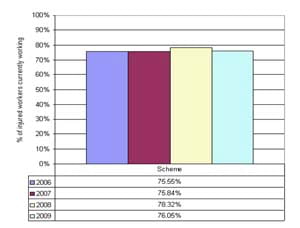Update: WorkSafe Vic

The rumours are wrong.
WorkSafe Victoria does not plan to withdraw from the National RTW Monitor. They express some concerns about the ability of the monitor to provide all the information they seek, and would like to increase the number of employees interviewed. However, they are planning on working with Campbell Research and Consulting to have the Monitor meet their needs.
WorkSafe agrees with stakeholders: a survey that assesses trends across jurisdictions over time is an important tool to help assess RTW policy initiatives.
The RTW monitor is only one of a series of ways jurisdictions assess their results.
Factors such as the kinds of assistance provided to employees, the reasons people have not return to work, a person's perception of their recovery and the attitude of the workplace are important influences on return to work outcomes. Assessing these ‘process’ factors or lead indicators can help policy makers understand whether their policy initiatives are effective.
Some jurisdictions run their own surveys, and Victoria runs two – the RTW Sustainability Survey and the Client Satisfaction Survey. These surveys have been designed to meet their specific needs.
In Victoria, the ‘Return to Work Sustainability Survey’ is undertaken around 18 months after an individual has lodged a claim that results in more than ten days off work. The survey incorporates a key question, “Are you currently working?” to ascertain whether the person is back at work.
For those who are willing, typically 50% to 60% of those surveyed, a full questionnaire is completed, which asks about RTW-influencing factors such as who assisted the employee, who was less than helpful, factors that have influenced the person’s return to work, and the worker’s job satisfaction.
The Return to Work Sustainability Survey asks questions not dissimilar from the Return to Work Monitor. The sustainability survey interviews a much greater number of people, typically 2,500 to 3,000. A survey that includes a larger number of people is considered to be more reliable.
However, there has been substantial variation in the proportion of people answering the return to work question, with the proportion of employees (who could be contacted) answering this question varying between 67% and 90%. To increase the likelihood that the key return to work question is answered, this year the person interviewed did not need to complete the whole survey. This can change the mix of people responding to the question. In turn, this increases the chance of the results being skewed, making it harder to compare year on year values.

The graph shows the results of the RTW Sustainability survey over the last four years. The results do not show a consistent downhill trend, as seen in the Return to Work Monitor results. The survey methods are different, the time the survey is undertaken is a year apart (six months after a claim in the RTW Monitor, 18 months in the Sustainability Survey).
Which survey should be used? When a large number of people are interviewed the results can be explored by industry, by WorkCover Agent, by gender etc. This is a major advantage in the Sustainability Survey, which interviews up to 3,000 people. When changes over time are the focus, the survey should be stable. That is, the questions are the same, the timing of the interview is the same, much the same proportion of people completes the survey etc. This is the advantage of the RTW Monitor survey.
WorkSafe has kindly invited us to discuss these issues further in the New Year. We are grateful for their invitation and will take that up.

